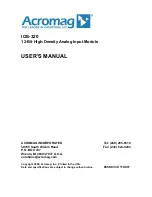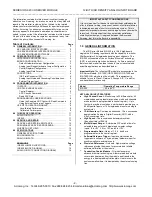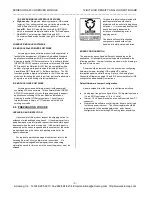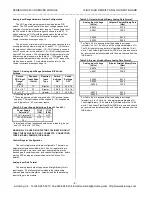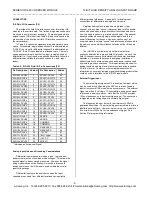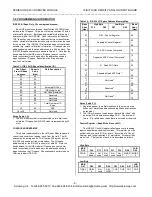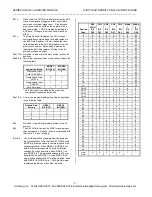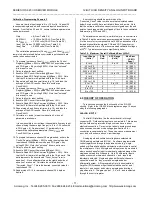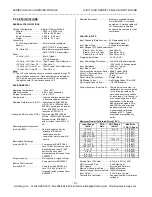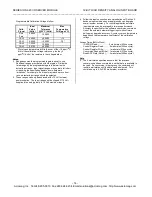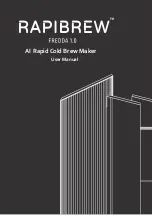
SERIES IOS-320 I/O SERVER MODULE 12-BIT HIGH DENSITY ANALOG INPUT BOARD
__________________________________________________________________________________________
- 8 -
Acromag, Inc. Tel:248-295-0310 Fax:248-624-9234 Email:solutions@acromag.com http://www.acromag.com
ADC Convert Command - (Write, Base + 10H)
The ADC Convert Command is a write only register (will not
respond to reads) that is used to trigger a conversion. The data
written to this location should be all ones to reduce digital noise,
although the write action alone is sufficient to trigger the
conversion. Note that a write to this register during an A/D
conversion will have no effect. Execution of this command
requires 1 wait state.
D15...D00
FFFF
NOTE: "FFFF" means that all bits are programmed as ones.
Read ADC Data - (Read, Base + 20H)
Use the Read ADC Data command to read the results of the
last ADC conversion. This command should be used following
the ADC Convert command or an external trigger input. Bit 15
(CTRIG) in the Control Register can be used to determine if a
conversion has been triggered, either by software command or
external trigger input. Bit 14 (Data Ready) in the Control Register
can be used to determine if a conversion has been completed. If
the Read ADC Data command is executed while the ADC
conversion is taking place, then the IOS-320 will institute wait
states until the data is available (up to 4.5 uS) before providing
the ADC data and completing the cycle. Execution of the read
command requires 2 wait states, if the ADC conversion
completed prior to initiating the read command. The execution of
this command will reset the CTRIG and Data Ready bits in the
Control Register.
The 12-bits of data are left-justified within the 16-bit word.
The four LSB's will always read as 0. Data format is Straight
Binary. A Reset will set all bits of this register to „0‟.
MSB
D15
D4
LSB
D03
D0
ADC DATA
0 0 0 0
PROGRAMMING CONSIDERATIONS FOR ACQUIRING
ANALOG INPUTS
The IOS-320 provides two different methods of analog input
acquisition to give the user maximum flexibility for each
application. The following sections describe the features of each
and how to best use them.
Using the Separate ADC Convert and Read Commands
Use of the separate convert and read commands is a
straightforward and accurate way to acquire data. This method
is useful for most applications.
Programming Example (Separate ADC Convert & Read)
NOTE: For this example it is assumed that the external trigger
input is NOT being used to trigger conversions.
1. Write to the control register to configure the acquisition mode,
gain, and channel selections.
2. Delay to allow for input settling.
3. Execute the ADC Convert command.
4. Write to the control register to configure the acquisition mode,
gain, and channel selections for the next acquisition - if they
are different. This may be done while the conversion is in
progress because the ADC is in the hold mode.
5. The ADC conversion takes several microseconds. This time
can be put to use for other purposes (e.g. calibration of ADC
channel data).
6. Read ADC Data - if the conversion is still in progress, the
read command will generate wait states until it can deliver the
data.
7. Repeat steps 3-6 as required to acquire additional analog
input samples. Note that the input settling delay does not
have to be inserted, since writing to the control register to
configure for the next acquisition, immediately after initiating
the previous conversion, will allow the input to adequately
settle before the next conversion is started. The overlapping
of these tasks with the ADC conversion cycle is what gives
rise to "pipelined" operation and maximum system
throughput.
Using External Conversion Triggers
External hardware triggers are generated by the user via an
external TTL compatible input through the field I/O connector
(see Section 2) - make sure that all pertinent voltage and pulse
width constraints are met. The conversion is initiated on the
falling edge of the external trigger signal. This type of conversion
triggering is useful for synchronizing the ADC conversion of
analog inputs (e.g. several IOS-320's) to external events. Precise
time intervals between conversions can be achieved with an
external timing device. Note that external triggers that occur
during an A/D conversion cycle will be ignored.
Programming Example (External Conversion Trigger)
NOTE: For this example it is assumed that the external trigger
input is being used to trigger conversions.
1. Write to the control register to setup the acquisition mode,
gain, and channel selections.
2. Delay to allow for input settling.
3. Poll Bit 15 (CTRIG) in the control register to determine when
an ADC conversion has been triggered (this assumes some
prior knowledge in the application program that a hardware
external trigger will occur for a particular channel's
conversion).
4. Read ADC Data - if the conversion is still in progress, the
read command will generate wait states until it can deliver the
data. The Read ADC Data command will reset the CTRIG bit
in the control register to prepare for the next external trigger.
5. Repeat steps 3-4 for acquisition of the same input.
Otherwise, repeat steps 1-4 as required.
USE OF CALIBRATION SIGNALS
Reference signals for analog input calibration have been
provided to improve the accuracy over the uncalibrated state.
The use of software calibration allows the elimination of hardware
calibration potentiometers traditionally used in precision analog
front ends. A comparison of the uncalibrated and software
calibrated performance is shown to illustrate the importance of
the software calibration.

